Oklahoma encompasses a diverse ecosystem that includes prairies, bottomland woodlands, grasslands, tundra, deserts, and mountains. The state hosts a variety of plants and animals because of its mid-continent location and its long east-west border. As a result, it offers some of the best bird-watching opportunities in the central United States.
Approximately 355 species of birds are regularly found within the state. Around 83 species are permanent residents, while 181 are nesting species. The rest of the species are either temperate migrants or neotropical migrants.
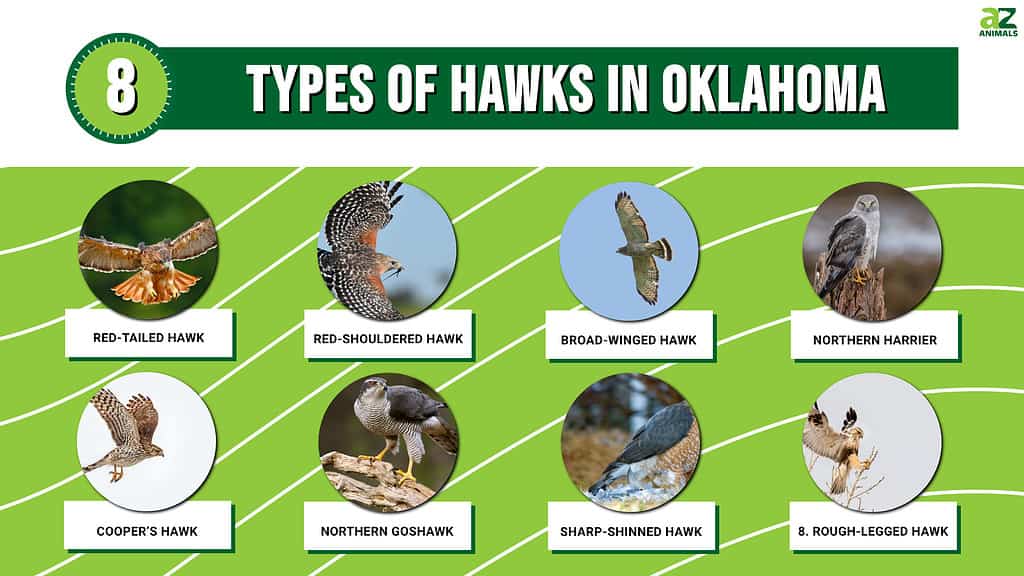
In this article, we look at the eight types of hawks often sighted within Oklahoma’s diverse range of habitats. Hawks are birds of prey with hooked beaks, sharp claws, and excellent eyesight. Some are migratory species, while others can be found in the state year-round. From the granite uplands of the Wichita Mountains to the Red Slough in the east, these raptors span almost all the ecosystems within the state.
Let’s take a look!
1. Red-tailed Hawk
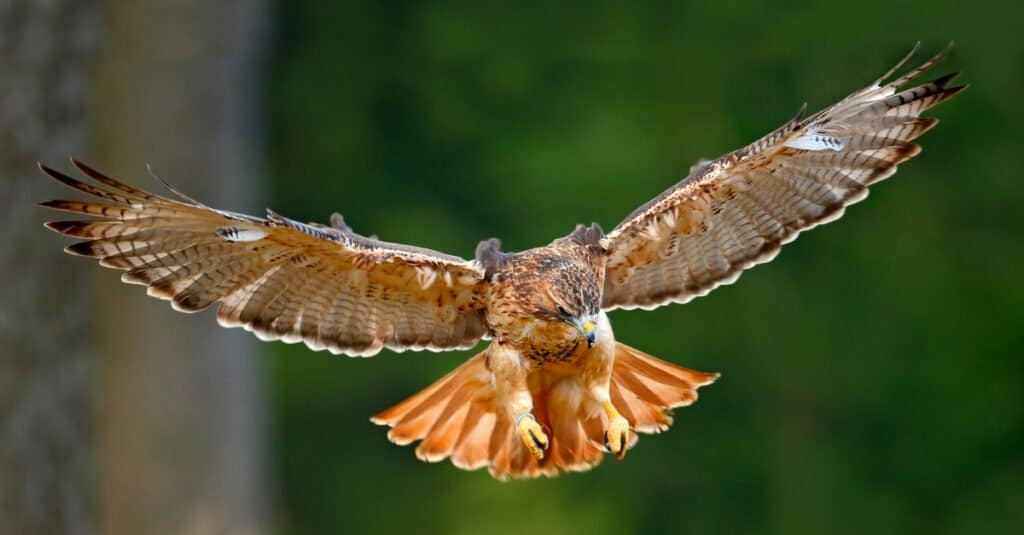
Red-tailed hawks build their nests on top of trees or cliff ledges.
©Ondrej Prosicky/Shutterstock.com
| Red-tailed Hawk | |
|---|---|
| Scientific name | Buteo jamaicensis |
| Weight | 1.5-3.5 lbs (680-1586 g) |
| Height | 18-26 in (45-65 cm) |
| Wingspan | 43-56 in (110-141 cm) |
Red-tailed hawks are large birds of prey that are found almost everywhere in Oklahoma. They have incredibly varied feather patterns but with distinct red tails. They generally prefer to inhabit the open woodlands, but they have no problem adapting to any kind of terrain that provides both high perches and open grounds for hunting.
Red-tailed hawks are incredible hunters and brilliant birds of prey. They eat a variety of foods depending on their location and season. Their favorite foods include ground squirrels, moles, rabbits, and mice. They are also known to eat other small birds and lizards. These hawks usually hunt from a raised perch. Once they catch sight of prey, they swoop down to capture it using their sharp talons.
Red-tailed hawks build their nest on top of trees or cliff ledges. They can also build their nests on artificial structures like tall buildings or the arms of some huge giant cactus. Their nests consist of huge sticks lined with softer materials. Females lay between 3 and 5 eggs that hatch in 28-35 days.
2. Red-shouldered Hawk
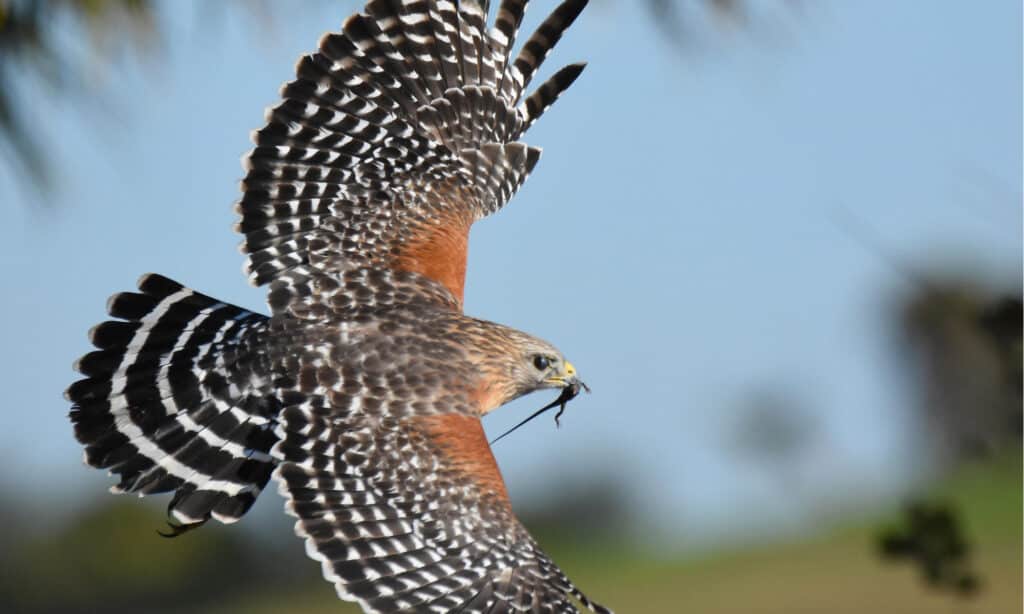
Red-shouldered hawks are opportunistic hunters that feed mainly on small birds, chipmunks, voles, and large insects.
©MTKhaled mahmud/Shutterstock.com
| Red-shouldered Hawk | |
|---|---|
| Scientific name | Buteo lineatus |
| Weight | 1-1.7 lbs (486-774 g) |
| Height | 15-24 in (38-61 cm) |
| Wingspan | 35-50 in (90-127 cm) |
Red-shouldered hawks are found throughout the year in the eastern half of Oklahoma. They are medium-sized birds of prey with black and white striped feathers and a red barring on their chest. They also have a squared wingspan with a translucent crescent near their wingtips.
These hawks inhabit the woodlands, often along rivers and swamps. They nest in deciduous and mixed forests. Both sexes build the nests using sticks lined with moss, bark, and other green vegetation. Females lay between 3 and 4 eggs. Incubation lasts about 33 days.
Red-shouldered hawks are opportunistic hunters that feed mainly on small birds, chipmunks, voles, and large insects. They may also eat crayfish on some occasions. They hunt by watching for prey from a perch or by flying low over open areas in search of a meal.
3. Broad-winged Hawk
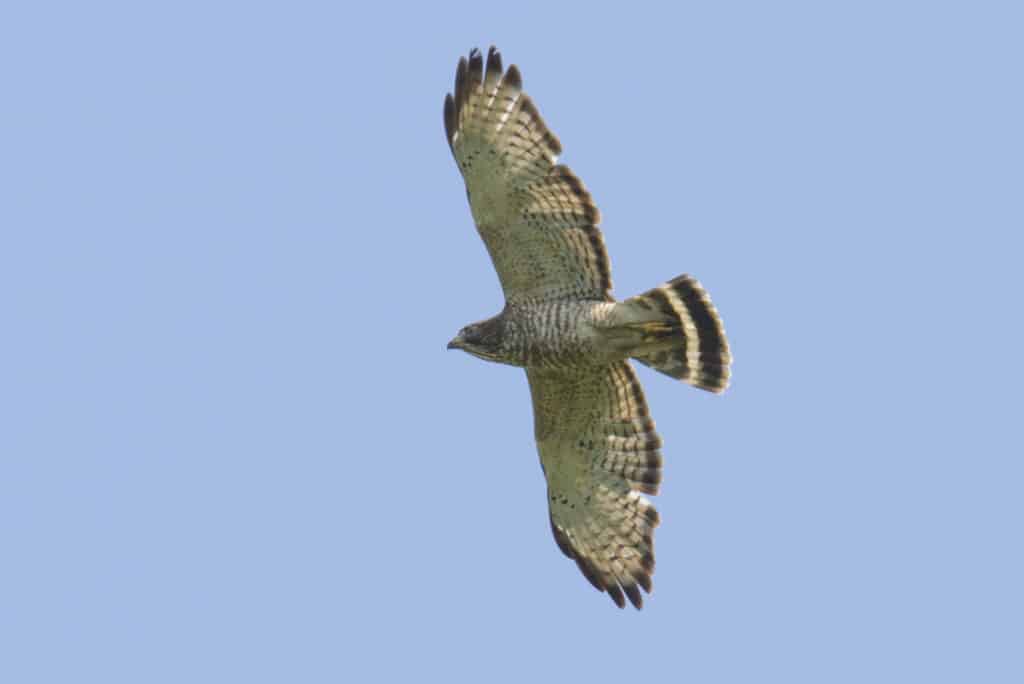
Broad-winged hawks have a wingspan of up to 39.4 inches.
©iStock.com/lrh847
| Broad-winged Hawk | |
|---|---|
| Scientific name | Buteo platypterus |
| Weight | 9.3-19.8 oz (264-561 g) |
| Height | 13.4-17.3 in (34-44 cm) |
| Wingspan | 31.9-39.4 in (81-100 cm) |
The best time to see broad-winged hawks in Oklahoma is during their fall migration. They are small raptors with broad wings. Adults have reddish-brown heads with black and white bands on their tails. The immatures are light brown with streaked underparts. They are widespread in Oklahoma’s woodlands in summer.
These hawks breed in coniferous or deciduous forests. They also don’t have a problem nesting in mixed coniferous and deciduous forests, usually near water sources or edges. Females lay between 2-3 eggs that hatch in about 28-31 days.
Broad-winged hawks feed on birds, squirrels, voles, large insects, lizards, snakes, and other mammals. They hunt by watching for prey from a raised perch. They also hunt by flying through the woods, actively searching for prey.
4. Northern Harrier

Northern harriers feed mainly on small birds, from songbirds to the size of small ducks, flickers, and doves.
©Harry Collins Photography/Shutterstock.com
| Northern Harrier | |
|---|---|
| Scientific name | Circus hudsonius |
| Weight | 11-27 oz (300-750 g) |
| Height | 21-25 in (53-64 cm) |
| Wingspan | 41-46 in (103-117 cm) |
Northern harriers are slim, medium-sized raptors found in Oklahoma year-round. They have pretty long, broad wings and a rounded tail. Females and immatures are brown with black-banded tails. Males are gray on top and whitish below. Their faces are very similar to that of an owl if you take a closer look at them. They are usually seen flying low in open country.
These hawks inhabit prairies, marshes, and fields. They often nest in the marshes, though you may also find them nesting in dry open fields. Females construct the nest while males supply the materials. Females lay between 4-6 pale bluish-white eggs. The incubation period lasts for about 30-35 days.
Northern harriers feed mainly on small birds, from songbirds to the size of small ducks, flickers, and doves. They also eat rodents, insects, lizards, frogs, and toads. They usually hunt by flying over fields or may try to locate some prey in dense cover.
5. Cooper’s Hawk

Cooper’s hawks inhabit wooded areas and forests but prefer to nest in tall trees with an extensive canopy.
©Richard G Smith/Shutterstock.com
| Cooper’s Hawk | |
|---|---|
| Scientific name | Accipiter cooperii |
| Weight | 7.8-14.5 oz (220-410 g) |
| Height | 14-20 in (35-50 cm) |
| Wingspan | 24-39 in (62-99 cm) |
Cooper’s hawks are found throughout Oklahoma. You will likely see them near bird feeders and in backyards, hunting for songbirds. They resemble sharp-shinned hawks, though they have distinctive red eyes, which are also larger.
Cooper’s hawks inhabit wooded areas and forests but prefer to nest in tall trees with an extensive canopy. Under favorable conditions, females lay between 3 and 5 eggs that hatch in about 34-36 days. Breeding attempts may be compromised by chemical pollution, predators, and poor weather.
Besides songbirds, Cooper’s hawks also feed on smaller mammals like mice, chipmunks, ground squirrels, tree squirrels, reptiles, and large insects. They are also vulnerable to predation by raccoons, red-tailed hawks, and great-horned owls.
6. Northern Goshawk
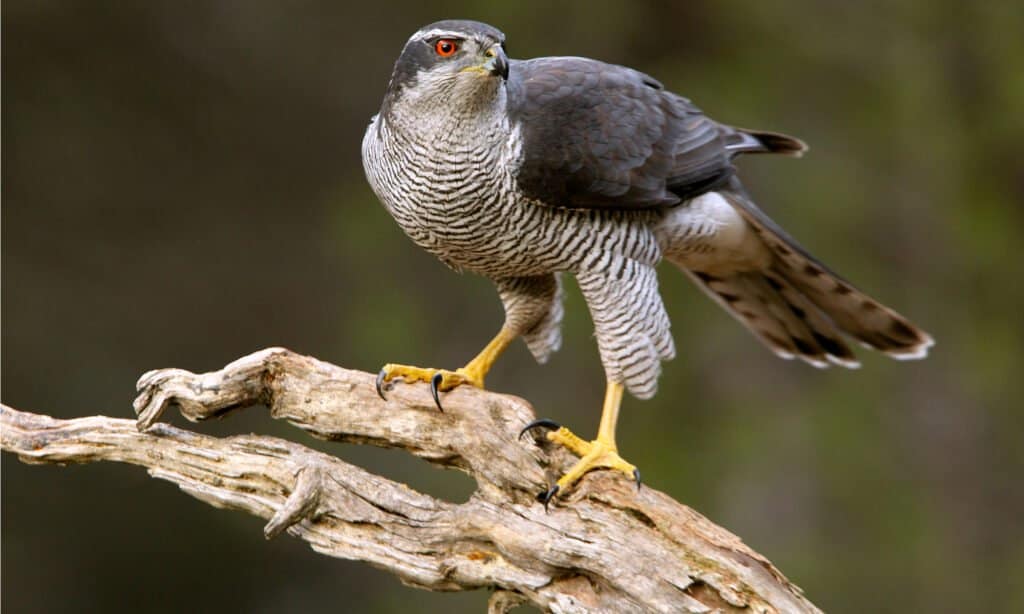
Northern goshawks feed primarily on medium-sized birds, snowshoe hares, rabbits, squirrels, and small rodents.
©Jesus Giraldo Gutierrez/Shutterstock.com
| Northern Goshawk | |
|---|---|
| Scientific name | Accipiter gentilis |
| Weight | 1.4-4.8 lbs (635-2177 g) |
| Height | 18-27 in (46-69 cm) |
| Wingspan | 40-46 in (103-117 cm) |
Northern goshawks are very secretive birds that are hardly seen in Oklahoma. They can be found in hardwood deciduous trees or coniferous forests. They have dark gray plumage with fine barring on their underparts.
These hawks are the most potent predators that take prey by putting up short bursts of swift flight. They hardly miss their target. Also, they feed primarily on medium-sized birds, snowshoe hares, rabbits, squirrels, and small rodents.
Northern goshawks nest on top of tall trees, often in deciduous trees in a mixed forest. The nest may be reused for more than one season. Females lay 2-4 bluish-white eggs. The incubation period takes around 32-38 days.
7. Sharp-shinned Hawk
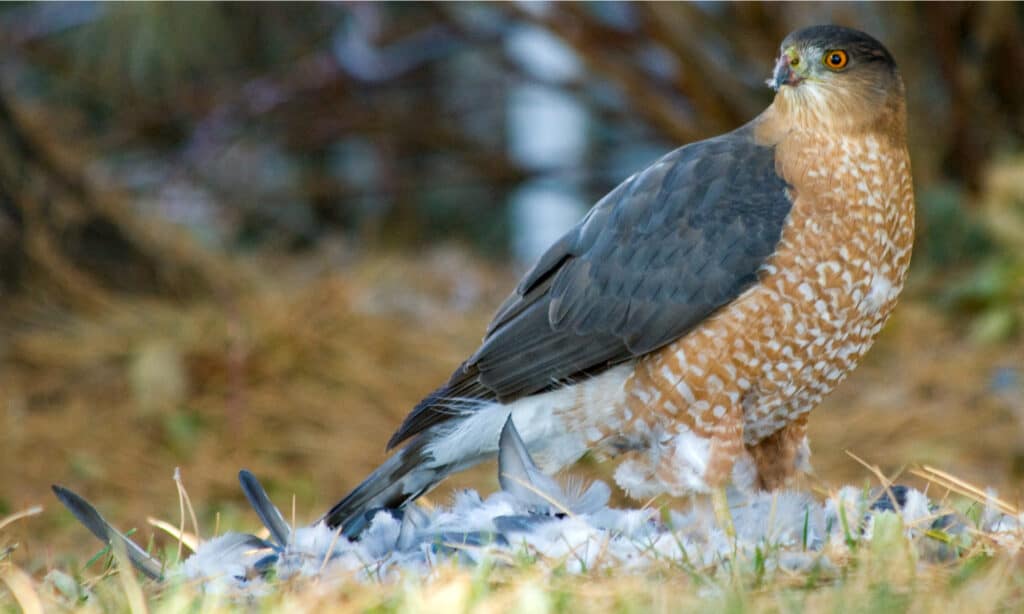
Sharp-shinned hawks breed in dense deciduous trees or pure coniferous forests.
©Wyatt W/Shutterstock.com
| Sharp-shinned Hawk | |
|---|---|
| Scientific name | Accipiter striatus |
| Weight | 2.9-7.7 oz (82-219 g) |
| Height | 9.1-15 in (23-37 cm) |
| Wingspan | 17-27 in (42-68 cm) |
Sharp-shinned hawks are the smallest in Oklahoma. They can be seen in dense forests or large open areas, especially in winter. They are widespread in the state during the non-breeding seasons. Adults are blue-gray above and have a reddish-orange stripe on their chests with dark-banded tails.
Despite being one of the smallest accipiters, these raptors have a fierce reputation. Like Cooper’s hawks, they are often spotted in backyards and bird feeders chasing after songbirds. They also hunt quails and a small number of rodents. Sharp-shinned hawks are, in turn, preyed upon by peregrine falcons and other large hawks.
Sharp-shinned hawks breed in dense deciduous trees or pure coniferous forests. You may also find them nesting in mixed woods. Females do most of the nest construction work, while males supply the materials. Females lay 4-5 eggs in a clutch. Incubation takes around 30-35 days.
8. Rough-legged Hawk
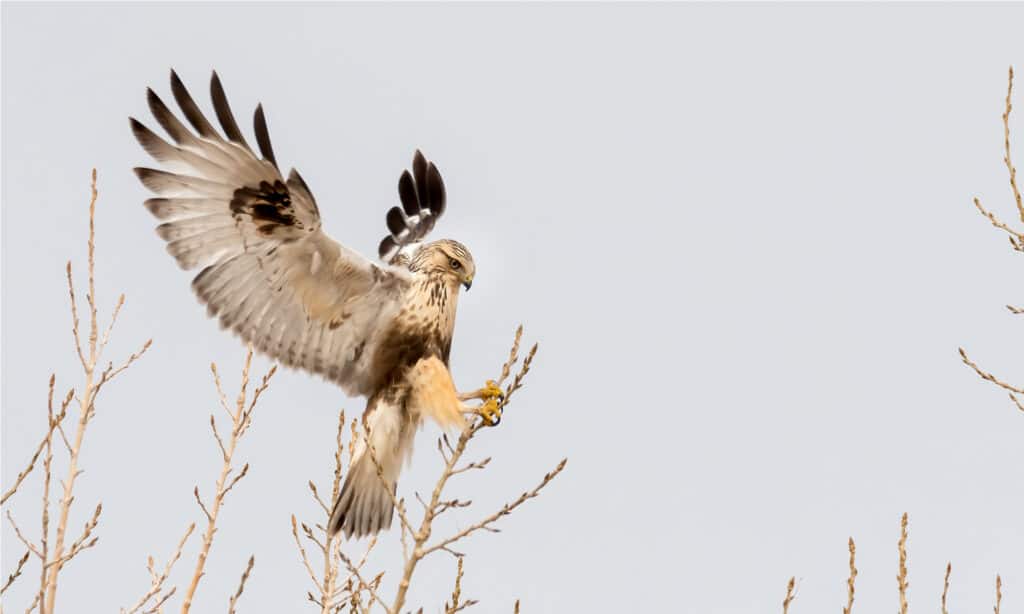
Rough-legged hawks spend their time far up north in the Arctic or subarctic regions during summer.
©Eivor Kuchta/Shutterstock.com
| Rough-legged Hawk | |
|---|---|
| Scientific name | Buteo lagopus |
| Weight | 1.32-3.66 lbs (599-1660 g) |
| Height | 18-24 in (46-60 cm) |
| Wingspan | 52-54 in (132-138 cm) |
Rough-legged hawks are medium-sized raptors found in Oklahoma during the winter months. They spend their time far up north in the Arctic or Subarctic regions during summer. They are the only soaring Buteo hawks that are tied to cold climates.
These hawks breed mainly on the tundra, in areas with tall trees or cliffs for nesting. The number of eggs laid by females depends on food availability, though they often lay between 3 and 5 eggs in a clutch. They hunt over open fields, watching for prey movement below. They primarily feed on lemmings and voles.
Rough-legged hawks have feathered legs that are an excellent marker to identify them. They also have chunky bodies, large wings, and long tails. They are dark-brown hawks with pale creamy plumage on their underparts.
The photo featured at the top of this post is © Eivor Kuchta/Shutterstock.com
Thank you for reading! Have some feedback for us? Contact the AZ Animals editorial team.






